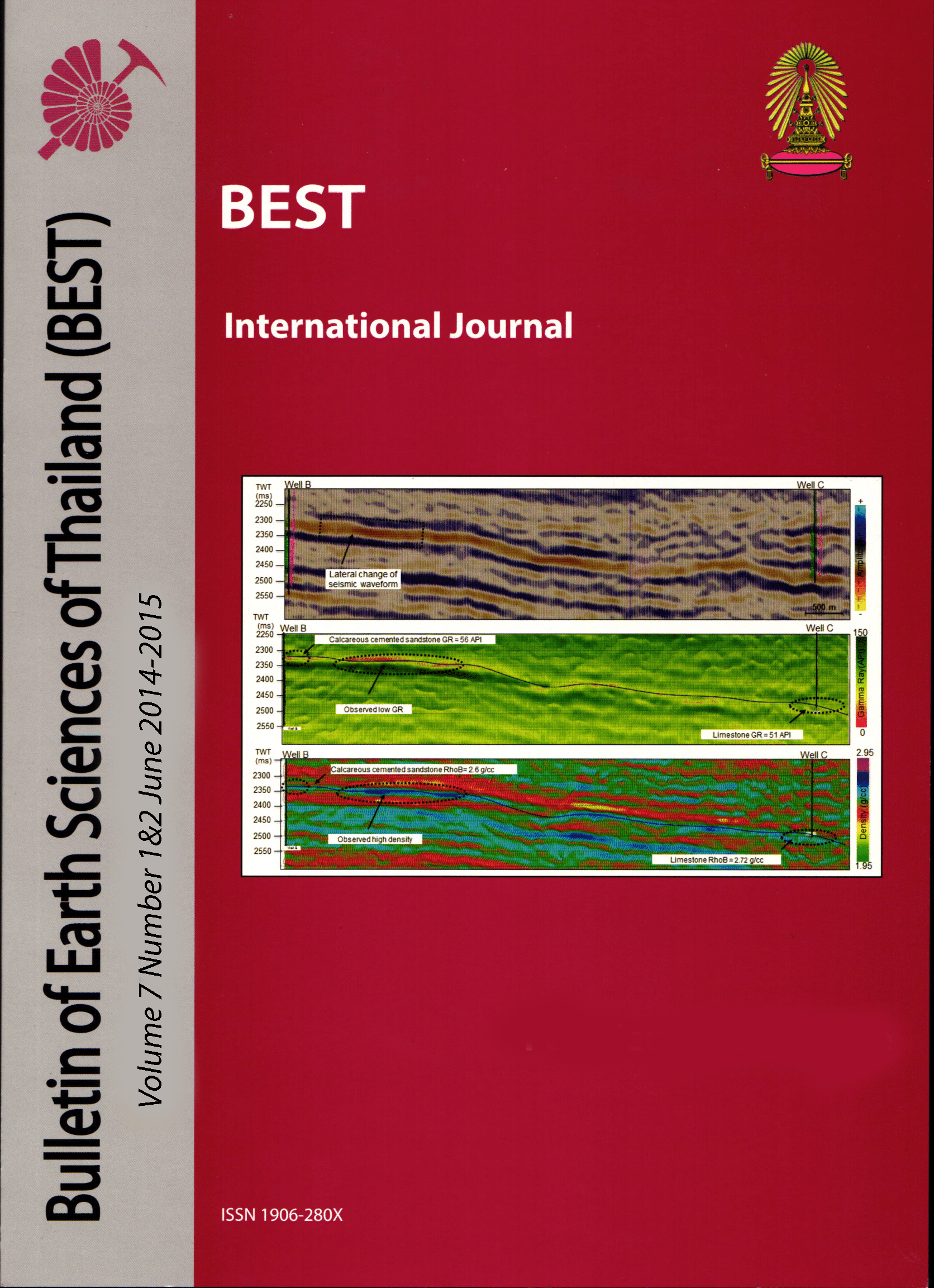Diagenesis and Porosity-Reducing Mechanism in Moragot Field, Pattani Basin, Gulf of Thailand
Main Article Content
Abstract
Lower to middle mid-Miocene sandstones are the petroleum reservoirs in Moragot Field, southern part of Pattani Basin, Thailand. These sandstones were deposited in continental, transitional and marine environments. This study combined wireline logs, thin section and scanning electron microscope to enhance the understanding of the diagenesis and porosity-reducing mechanisms in this area.
In general, porosity decreases with depth due to increasing overburden. A combination of cementation with a high clay content and poor sorting contributed destroying porosity. In contrast, quartz overgrowths have a positive correlation with porosity. Moreover, except quartz cement, dissolution of framework grains and cement also recovers porosity lost by diagenesis. The reservoir interval of Moragot Field is stratigraphically deeper than other areas plus the depositional environment changes to a transitional clay-rich environment.
Article Details

This work is licensed under a Creative Commons Attribution-NonCommercial-NoDerivatives 4.0 International License.
Copyright © 2008 Department of Geology, Faculty of Science, Chulalongkorn University. Parts of an article can be photocopied or reproduced without prior written permission from the author(s), but due acknowledgments should be stated or cited accordingly.
References
David, K., Davies and associates Inc., 1992, Petrographic x-ray diffraction and scanning electron microscopy analysis: percussion sidewell core samples Moragot no.2 well Gulf of Thailand, 88p.
Hinthong N, 2003, “Massive sands” Reservoir properties in Pailin field area, block12/27, Pattani basin, the gulf of Thailand, Based on the integration of conventional core and wireline log analysis in the Pailin-7 well , Master’s thesis, Chulalongkorn University, Bangkok, 64 p.
Hiatt, E.E. and Kyser, T.K., 2000, Links between Depositional and Diagenetic Processes in Basin Analysis: Porosity and Permeability Evolution in Sedimentary Rocks: p. 63-92 in Kyser, K., (ed.) Fluids and Basin Evolution, Mineralogical Association of Canada, Ottawa, Canada, 262 p.
Jardine, E., 1997, Dual Petroleum Systems Governing the Prolific Pattani Basin, Offshore Thailand: Petroleum Systems of S.E. Asia and Australia Conference, Jakarta.
Khunalai, M., 2006, Changes in porosity and permeability with burial: Comparative response in Miocene spay and fluvial channel sands, Pattani basin, offshore Thailand, Master’s thesis, University Brunei Darussalam, Brunei, 118p.
Pattani regional term., 1999, Pattani regional project Unocal concessions I, II, III and IV Gulf of Thailand.
Ramm M., 2003, Porosity-depth trends in reservoir sandstones: theoretical models related to Jurassic sandstones offshore Norway: Marine and Petroleum Geology, v. 9, no. 5, p. 553–567, doi: 10.1016/0264-8172(92)90066-N.
Reed, J.S., K.A. Eriksson, and M. Kowalewski., 2005, “Climatic, Depositional and Burial Controls on Diagenesis of Appalachian Carboniferous Sandstones: Qualitative and Quantitative Methods.” Sedimentary Geology 176, no. 3–4, p. 225–246, doi:10.1016/j.sedgeo.2004.11.003.
Saikia, C., A. H. M. Ahmad, and S. M. Wasim., 2003, “Facies Controlled Diagenetic Evolution of the Delhi Group Sandstones, Bayana Basin, Rajasthan.” Journal of the Geological Society of India 77, no. 3, p.261–268, doi: 10.1007/s12594-011-0033-4.
Siriporn, C., 2005, Depositional and diagenetic evolution in tertiary reservoir sands in Pailin field, offshore Thailand, focusing on core, wireline and isotope signature in Pailin-6 well, Master’s thesis, University Brunei Darussalam, Brunei, 108p.
Slatt, Roger M., 2013, “Basic Sedimentary Rock Properties.” Developments in Petroleum Science, p. 39–93. doi:10.1016/b978-0-444-56365-1.00002-x.


